FROM: SeaKayaker Magazine
Story by Spinnaker Wyss-Johnsen
Photos by Martin Leonard III
Martin Leonard III did what the paddling community said would be impossible, suicidal or perhaps just plain crazy. In 1996, Martin succeeded in paddling a route across the Arctic coast of the North American continent. He is, in all probability, the first modern-day kayaker to complete a coastal route through the fabled Northwest Passage-a route linking the Pacific Ocean to the Atlantic Ocean. He did it with the help of a designer who believes that industry standards are something to measure shoe size by, but never boats. And the motivation? Something called "traditional technology."
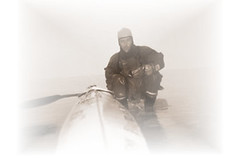
An avid kayaker for 25 years, Martin began going on sea kayaking expeditions 15 years ago as a way to better understand the cultures of Alaska's coastal communities. These expeditions have evolved into a lifestyle. For him, a kayak is an affirmation of the traditional technology of the Alaskan native peoples. He has paddled the majority of Alaska's open ocean coast, the Bering Strait, the Russian Far East and Canada's northern shores, covering some 10,000 miles and passing through seventy-five villages and hundreds of traditional camps. But what is more interesting than how far he traveled is how he did it.
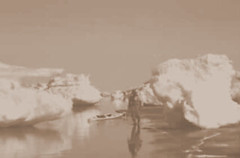
Martin started conceptualizing a high-speed expedition kayak to provide the edge he needed to make the most of the short Arctic summer paddling season. When I met Martin in Hawaii in 1992, he was looking for a racing kayak to modify for expedition use. Three years earlier, he had worked with the late Steve Sinclair (SK Aug. '96) to develop two surf skis for a trip across the Bering Strait. The surf ski had a fast, low displacement hull and enough storage capacity for the kind of travel Martin envisioned. Martin had paddled the surf ski with a large international group in an exchange with Russian Eskimos to promote visa-free travel for locals after the fall of the Ice Curtain. "We encountered some storm conditions on the first portion of the crossing, and I found myself in the middle of the Chukchi Sea surrounded by fog on a very narrow, 19-foot-long wash-deck kayak. After 20 hours of paddling against strong winds and current with the kayak surfing the ocean swell, I remember thinking, 'This has real potential.'"
Martin and his partner, both on surf skis, were the only kayakers in the group to complete the crossing and traverse the Chukchi Peninsula. It proved the concept that touring with a fast hull was advantageous, but Sinclair's surf ski had its drawbacks. "Steve Sinclair and Tom Sherburne designed it as an ark for open ocean survival and storm sea paddling," said Martin. "It's a tremendous craft but, for my purposes, it was a bit heavy at 75 pounds, and its bulbous bow was a bit too buoyant and slowed the boat in certain conditions. It was also difficult to take to windward." Martin turned his attention toward finding a full-blooded racing kayak.
Around that time, my father, Hunt Johnsen, an innovative designer/shipwright in Hawaii, was also thinking about racing designs. According to Martin, "Hunt has a deep understanding of how boats move through the ocean on scientific, practical and artistic levels. He builds beautiful boats with exceptional performance-they are usually ahead of their time and blow people away," he comments.
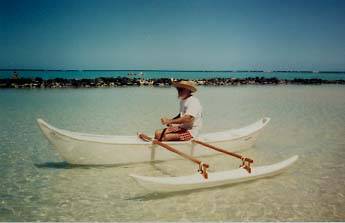
After years of watching racing surf skis of varying designs careen across the Moloka'i Channel, Hunt knew he could build one that was faster and that had more ocean savvy. In 1991, he built a surf ski he called the "Cheetah." The final design was 20 feet long and had a reverse transom and an ocean-going bow, proving itself exceptional in ocean swells. Its round hull and 14.5-inch waterline beam, influenced by an Olympic K-2, contributed to its speed at the expense of stability: It had none. It had only a brief resistance when leaned at 45 degrees. The Cheetah collected dust.
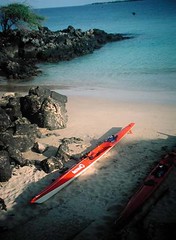
A few months before meeting Martin, I had dug the Cheetah out of the boat yard and launched it. I spent the first day with my legs hanging over the side like training wheels. Once I got a bit of speed, the boat became slightly more stable. Just when I thought I'd gotten the hang of it, I'd find myself upside down. To say the Cheetah teaches you good balance and bracing skills in a hurry is an understatement. After a couple of days, I could keep the Cheetah upright, and I was quickly hooked on its speed.
When Martin and I met, I introduced him to the Cheetah. Initially, we used the Cheetah with wing paddles to train and do short expeditions in Hawaii. We moved the rudder farther forward under the hull to eliminate ventilation in swells, and eventually Hunt designed the retractable skeg/rudder assembly. Support from resin manufacturer System Three and fabric from Hexcel and Dupont allowed us to experiment with various layups, which became lighter, tougher and more resilient until we were satisfied with an expedition layup.




For the Arctic version of the Cheetah, Hunt also redesigned the sit-on-top deck to accommodate a low-profile, Olympic-style cockpit. This type of cockpit offered protection in Arctic climates without compromising proper leg drive when using the wing paddle. It also had the added benefit of easy entry and exit, which was important given the unstable hull. Thigh straps anchored to the inside of the cockpit provided a firm connection to the boat, allowing total control and rollability.
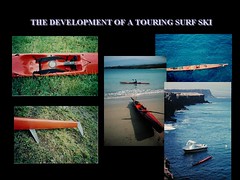
VIEW THE SLIDESHOW OF
THE ORIGINAL PROTOTYPE CHEETAH SOT
The final Arctic Cheetah, constructed of Kevlar, S-glass and epoxy, weighed only 35 pounds. It utilized cutting-edge construction materials and techniques, and was virtually indestructible: It was a modern touring kayak that was faster, lighter and stronger than any other. Foam-core construction eliminated the need for internal pillars, which gave Martin the extra storage space needed for long expeditions. An innovative "trimmable" seat and foot steering bar assembly were completely removable and eliminated the need for hatches. All equipment was stored and easily accessible in stow bags, leaving nothing but safety lines on the deck. Every detail was designed to withstand the rigors of the Arctic, and to be field repairable in an emergency.
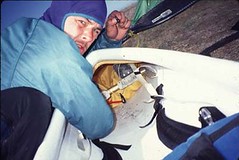
Having already paddled the coastline between the North Pacific Ocean and Inuvik, Canada, in previous years, Martin set his sights on reaching Hudson Bay, over 2,000 miles to the east. Paddling the Arctic Cheetah and carrying an "alpine style" expedition kit (see Appendix) weighing only 30 pounds, he could travel fast and light, taking advantage of the short and fickle Arctic paddling season. This method also gave him the ability to drag or carry his kayak and gear in one trip, without unpacking, which cut any portage times significantly.
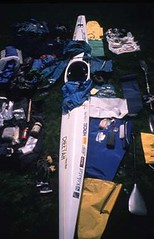
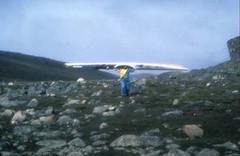
With the creation of the expedition kayak complete, the second half of the venture lay in the paddler's skill. Martin set out to increase his ability and refine his technique in order to paddle the Arctic Cheetah with maximum efficiency. "Traditional kayakers built the best craft they could and had the skills not only to paddle them, but to hunt from them," says Martin. "The evolution of kayaks did not always lead to wide, stable craft. It led to sleek, tippy kayaks. Doing an expedition in a racing kayak meant that I, too, would have to rely on my skills."
In July of 1995 Martin set out from the Mackenzie River Delta, Northwest Territories, Canada, heading east on a solo quest to reach the Atlantic Basin. During one of the worst weather seasons in decades, he navigated 1,250 miles in 25 paddling days, an average of 50 miles per day. On the first leg of his journey, drought conditions left stream beds dry and eliminated a portage, adding an unexpected 150 miles to the 300-mile section. By paddling 78 miles in a single day, he managed to reach safety in the middle of a storm, arriving at the village of Paulatuk in the endless twilight of a summer night.
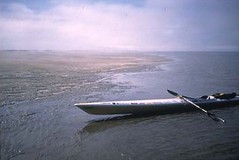
In remembering some of his difficulties during that 1995 season, Martin says, "I can honestly say I've seen the Eastern Beaufort Sea at its worst-and it's not a time and place I'd want to revisit." Martin had waited for the ice to retreat to the north, leaving free and easy passage-until summer storms kicked up the seas. "It was the worst weather folks had seen for 15 years. The three capes, Dalhousie, Bathurst and Parry, lived up to their reputation as the Gatekeepers of the Central Arctic. I had high winds, up to 50 knots, and really nasty conditions at each prominence. The shallow sea, combined with a flat, featureless coastline, made navigation very difficult. A mile off shore with no land in sight, I'd run across sandbars."
The run to Dolphin and Union Strait was also tricky, Martin recalls. "I experienced some of the biggest seas I have been in during my six years of paddling above the Arctic Circle. The wave height was not the problem, it was the short wave length that developed from nearby Arctic storms. The Cheetah was designed for big ocean swells. In the choppy seas, the boat was a bit out of place. It was very challenging paddling, but I still made good time."
Martin attributes his successful navigation to the shared traditional knowledge base of the Inuit who live in the region and have traveled this route for centuries. "I purposely did very little of the usual historic, scientific or geographic background investigation prior to the '95 and '96 seasons. The route finding and selection was based on local knowledge and lore gathered through personal interactions with elders, hunters and other ocean travelers."
![ct20016r[1]](http://static.flickr.com/5/5198513_d1df948c0b_m.jpg)
![ct20013r[1]](http://static.flickr.com/5/5198498_f579eef6e3_m.jpg)
Martin is quick to point out that, "Inuit roamed the Arctic in kayaks and umiaks long before renowned 'Euro Northwest Passage explorers' retraced their living migration routes and passages." He maintains that the route should be named the 'Inuit Passage' in respectful recognition of the people of these Northern regions.
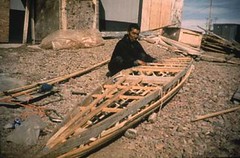
He made week-long stopovers in each of the villages to meet with friends and acquaintances and to collect route information, often in conjunction with waiting out bad weather. "On a map it's very difficult to delineate portages; however, local hunters told me of small lakes and rivulets I could take. Invariably, I found the routes to be exactly as they had described them. Many times the hunters could not remember the last time a kayak had been through the passages, but they always knew precisely how the kayaks used to travel from village to village." When an early winter set in during the second week of August, Martin put the Arctic Cheetah on storage racks in the central Arctic village of Umingmaktook.
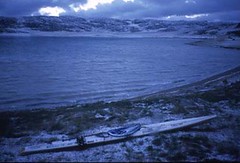
In mid-July 1996, Martin Leonard reunited with his kayak and departed from the village of Umingmaktook to begin the final leg of his journey toward the Atlantic Ocean. "The real key to the second season was the use of the traditional portage at Itibliyaruk on the southeast side of the Kent Peninsula. It allowed me to avoid the ice-choked Dease Strait and enter the Queen Maud Gulf quickly, in conjunction with breakup." The weather was favorable and the pack ice in the Queen Maud Gulf had moved offshore; there was nothing to slow his progress eastward. He paddled for 10 or 15 hours at a stretch, eating Powerbars and dried caribou meat while in the boat and making good time.
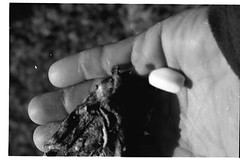

The journey was enchanting: The weather was calm and sunny and there was lots of new terrain around each bend in the coastline. "Some days I just didn't want to stop! At the end of a long stint I often made excuses not to stop, but eventually I always found a nice spot with water nearby, crawled into the tent and listened to the worldband radio until I fell asleep."
"I didn't see another person for a 400-mile stretch, but there was always wildlife around-Arctic summers are so full of life." On one occasion Martin landed at the mouth of a bay near a traditional whaling camp. As he set up for the night on a gravel spit, beluga whales began to leave the bay. "There was a bunch of young whales in the pod. They all played as they traveled, spyhopping and chattering to each other. A steady stream poured out of the bay, then more, and more! It must have been a few hundred animals. I made dinner and fell asleep on the beach next to the fire, listening to their breath and chirps."
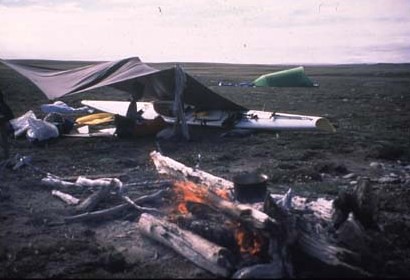
Farther east, the low-lying coastal plain of the Adelaide Peninsula went on as far as the eye could see. One evening Martin tucked his camp behind a small bluff for the night, the only protection from the wind for miles. "I got up in the middle of the night and my tent was surrounded by sleeping caribou, about 30 of them. I was so tired I just said hello and went back to bed. In the morning I had to check for tracks, just to be sure it wasn't a dream. You know you've picked a good campsite when your evening company is a herd of caribou."
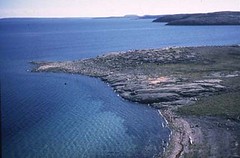
It wasn't unusual, after finding a good campsite, to find traces of others also having been there. It may have been years, sometimes centuries since the last traveler had set foot in the area, but rest assured that where the modern traveler seeks shelter from the storm, so had the ancients. He found old tent rings, skeletons of boats, turn-of-the-century tools, even an old car with a rotting wooden frame.
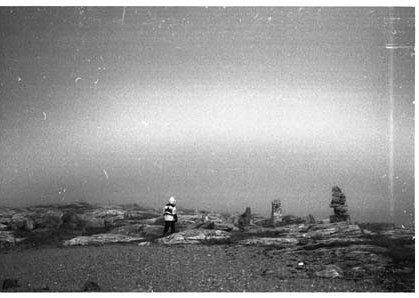
The Arctic has seen a fair number of visitors during the last couple of thousand years, and not all of them survived. Near the south side of King William Island, inukshuks (Inuit rock pile sculptures resembling a human form) marked important water holes. "Rock cairns marked the winter trail, and I couldn't help but think of the frozen remains of the ill-fated Franklin expedition found nearby. (In 1845, Sir John Franklin ventured from England with two ships, hoping to locate the fabled Northwest Passage. The expedition vanished in the Arctic, initiating years of fruitless search and rescue efforts.) In seeing these sites, Martin felt confirmation that his light and nimble traveling style was certainly advantageous. He would not get frozen in for the winter.
About halfway to his final destination of Repulse Bay in northern Hudson Bay, Martin encountered the Gulf of Boothia, a region known in the maritime community as unnavigable and uncharted. What's it like? I asked. "Ice and polar bears," he said over the static and delay in the phone line from Pelly Bay. "I'm a bit early, the ice is still tight, and the going is tedious. Between the polar bears, ice, and a waning summer season, there've been lots of very anxious moments. I'm never sure what will await me around the next corner."
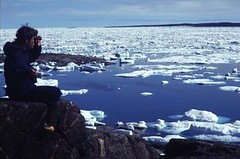
Several days prior to reaching Pelly Bay, as he was paddling through an area of high ice coverage, he rounded an iceberg and saw a polar bear sleeping on the ice about 50 yards away. With bated breath he maneuvered his way through the ice and past the bear and spent the next few hours looking over his shoulder, fully expecting to see it stalking him. He saw a total of four polar bears that day: the lone young male and a sow with two cubs. He camped that night on an ice-bound beach without getting much rest, keeping his shotgun in hand as he dozed with fitful dreams of man's only predator. "Traveling in heavy bear country is very intimidating, and traveling solo is even worse; there is no one to outrun!" he said with a chuckle. It wasn't until later, when he reached the ice-free waters in the southern corner of Committee Bay, that he relaxed his watch for polar bears.
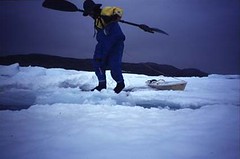
While resupplying in Pelly Bay, he met renowned Canadian paddler Victoria Jason. Victoria was hoping to paddle to Repulse Bay, but the Elders had persuaded her that this was not a good year to travel solo in the Gulf of Boothia. Too many bears, and the ice conditions were marginal. Martin concurred, so the two teamed up for the remaining section of coastline. After negotiating the southern shores of the Gulf of Boothia, they had one more section to complete before reaching the Atlantic Ocean. He outlined the conditions and the route around the Simpson Peninsula and into Committee Bay: "Ice coverage is very high. I've watched it moving at about 6 to 8 knots...loose pack ice and growlers grinding against steep cliffs.
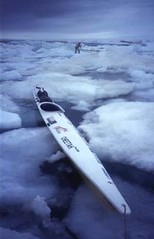
All this amidst a tidal current running on a range of about 11 feet. Paddling at high tide around grounded ice should allow passage. Once around the west side of Committee Bay, it's only a 45-mile journey across the Rae Isthmus. I will be doing some short portages, crossing a few large lakes and negotiating a couple of whitewater rivers. I'm following a well-known traditional route. I'll be in northern Hudson Bay in no time! The village of Repulse Bay is just a 15-mile paddle from the mouth of the North Pole River.
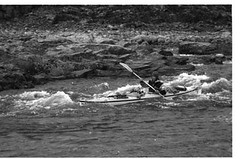
In late August I received a voice-mail message from Martin. He was whistling a favorite Inuit tune from the Greenland Kayak Club. He described the final miles of the season paddling through thick fog on a compass course, when he came bow to bow with a huge ocean transport vessel. The ship was the Matilda Desgagnes, and he noted her home port: Montreal! He was in the Atlantic at last.
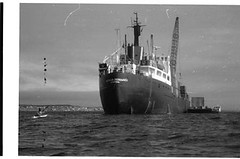
"It was a fitting meeting for me, after traveling across one of the most challenging oceans in the world via traditional means. I paddled alongside this testament to modern man, this massive cargo ship. I reveled in the fact that this ship would never see the route I had taken. The encounter just reinforced what I feel about our modern society and how so often traditional technologies are cast aside as being obsolete. It's a trend that I'm glad is beginning to change with younger generations who are learning to balance the two."
"It has been a remarkable journey," said Martin. "On the adventure side, the open ocean in a very small boat is always a very humbling experience. From a cultural perspective, the kayak still is a powerful symbol of Native spiritual and traditional values, as well as their technological ingenuity."
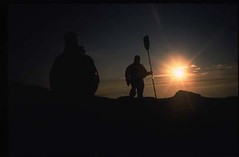
________________________________
Hunt and Judy Johnsen are still designing and building WaveWitch paddlecraft and can be reached at hjdww(at)gte.net
Martin Leonard III lives and works in Bethel, Alaska, as a project manager for the National Science Foundation and the University of Alaska Fairbanks Kuskokwim Campus. When not at work or going on expeditions, he can be found building "concept" paddle-craft, ice-bikes and kayak-surfing ocean swells in Hawaii and Alaska.
For more information regarding route, equipment or traditional technology projects, you can contact Martin: qayaq_alaska(at)yahoo.com and geocities.com/qayaq_alaska/

Dedicated to Vicki...We Miss You!